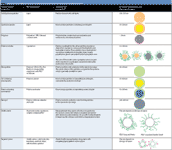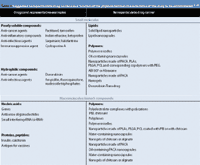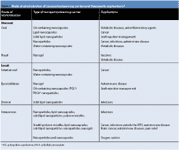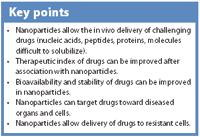Developing nanoparticle drug carriers
Pharmaceutical Technology Europe
Nanoparticulate drug carriers include a class of particles made of polymers or lipids that - because of their size and chemical composition -permit systemic and local treatment.
Nanoparticulate drug carriers include a class of particles made of polymers or lipids that — because of their size and chemical composition —permit systemic and local treatment.
In general, these systems are expected to protect a drug from degradation, enhance drug absorption by facilitating diffusion through epithelium, modify the pharmacokinetic and drug tissue distribution profile and/or improve intracellular penetration and distribution.1–3
They can be administered by all possible routes of administration, generally improving both bioavailability and therapeutic efficacy of the carried drug.3 They represent an alternative class of vehicles to liposomes to transport drugs straight to the targeted diseased cells in the body.

Table 1 Definition of the different types of nanoparticulate drug carriers and schematic representations.4â18
Numerous types of nanoparticle drug carriers have been developed (Table 1). The range of applications includes the treatment of all major public health diseases including severe infections and cancer. They are also strongly believed to potentially solve the problem of the in vivo delivery of biomimetic molecules such as nucleic acids, proteins, peptides and very insoluble drugs, which is very difficult by other means (Table 2).
Although several liposomal formulations have been marketed since 1995 — illustrating that nanotechnology can be used to administer toxic drugs such as antifungal and anticancer agents — two new formulations for polymer nanoparticles entered clinical trials recently for cancer therapy.
This article focuses on the development of nanoparticulate drug carriers, highlighting several of the key issues being addressed up to now.

Table 2 Suggested nanoparticulate drug carriers as a function of the physicochemical characteristics of the drug to be administered.3â31
Design
The design of nanoparticulate drug carriers must fulfil the following requirements:
- Composition must be acceptable for use in human therapy (biodegradable, biocompatible, nontoxic).
- Size must be suitable for administration to humans by different routes and allow diffusion inside the body to reach the biological target site.
- The biodistribution should suit the therapeutic target.
- The carrier must be loaded with the drug and should only release the drug in a controlled manner once the carrier has reached the biological target site.
Composition
As lipids are part of living constituents, they were considered to be suitable chemicals to formulate solid lipid nanoparticles (SLNs) and nanocapsules (LNCs) (Tables 1 and 2).
Synthetic polymers offer an almost infinite array of chemical composition and structure combinations. However, only a few have the requirements that make them useful as nanoparticulate drug carriers.
The prime candidates are polyesters including polylactide (PLA) derivatives and polyepsiloncaprolactone (PCL), polyalkylcyanoacrylate (PACA) and corresponding copolymers with polyethylene glycol (PEG), polysaccharides and polyethylenimine (Tables 1 and 2).
Natural macromolecules including polysaccharides (chitosan, alginate, pectine) were introduced to formulate hydrogel nanoparticles. Research is continuing to find suitable new polymers because polymers can be produced at lower cost than lipids and should be more interesting (economically) based on economic considerations.32 Polyesters of polymalic acid, polyamino acids of polybenzyl-glutamate) and pH- or temperature-sensitive species are growing in popularity.33–37
Size requirements and synthesis methods
Whatever the material constituting the drug delivery device, the second requirement is to produce particles small enough to diffuse across biological barriers encountered in the body to transport the drug from the administration site down to the target tissue and/or cells. Considering the mucosal route, the smaller the nanoparticles, the better they can transport drugs across mucosa.28,38
After intravenous administration, particles with a diameter less than 100 nm are generally less recognized by macrophages of the host defence system (macrophage of the mononuclear phagocyte system [MPS]) and can circulate for several hours in the blood stream. Their small size also promotes their diffusion through fenestration of the altered blood vessels found in diseased tissues.2
The various methods developed to prepare nanoparticulate drug carriers have been reviewed in several papers.11,12,17 The principle of the methods depends on the type of particles to produce, the raw material and the drug to be encapsulated. The diameter of the particles produced is generally below a few hundred nanometers.
The methods are reproducible and most of them can easily be scaled up to be industrialized (i.e., nanoprecipitation producing nanocapsules, anionic emulsion polymerization producing PACA nanoparticles, production of SLNs). Continuous processes also exist to produce nanoparticles by nanoprecipitation and SLNs.39 Emerging methods include environmental-friendly procedures based on the self-assemblage of macromolecules in aqueous solutions, gelation of hydrophilic gelling polymers, formation of lipid nanoparticles and nanocapsules, emulsion polymerization of pure monomers in a water continuous phase and methods using supercritical fluid carbon dioxide as the solvent.40–42
Biodistribution control
Reaching the ultimate goal of drug targeting requires that the fate of the nanoparticulate drug carrier will be perfectly controlled in vivo. This requires a specific design of the particle. As previously discussed, particle size is one parameter to consider.
Apart from the size criteria, the biodistribution of particles is greatly influenced by the interactions occurring between body components and the nanoparticle surface. Thus, another important factor includes the composition of the nanoparticle surface. For instance, coating nanoparticles with PEG reduces the opsonization on their surface hence the uptake by the MPS after intravenous administration.2,18,43
Thus, PEG-coated nanoparticles (i.e., 'Stealth' nanoparticles) remain in the blood for several hours while their uncoated counterparts accumulate in the MPS within a few minutes following administration. Recently, it was shown that the conformation of chains of macromolecules grafted on the nanoparticle surface also influences the interaction with blood components.44 Thus, depending on the coating material and conformation, it is now possible to suggest several general rules to design nanoparticles that deliver drugs either to macrophages of the MPS or outside the MPS area.2,3,34,45
Nanoparticles escaping the MPS uptake can be used to retain drugs in the blood compartment or to distribute therapeutic compounds in tumoural or inflamed tissues thanks to the local enhanced permeation retention effect occurring in diseased tissues.46 The specificity of recognition of the target cells by the nanocarriers requires a subsequent sophistication of labelling address, which must be attached on the nanoparticle surface too.19,45–47 Convincing results of targeting were obtained by coupling monosaccharides or folate residues on the nanoparticulate drug carrier surfaces.17,48–51
Other strategies are based on the covalent attachment of the biotin-binding protein, NeutrAvidin, enabling the binding of biotinylated drug-targeting ligands such as antibodies by avidin–biotin complex formation.52 More recently, specific nucleic acids named aptamers were considered for targeted delivery and uptake of nanoparticles in a cell-specific manner.53
It can be expected that the extension of the targeting strategy will progress further with new data from the biologists identifying possible specific target receptors on cell surfaces and corresponding ligands, and from progress in molecular imprinting techniques.54
For oral or nasal administration, the use of chitosan as a coating material of the nanocarrier surfaces may promote the bioadhesive properties of the drug delivery device on the mucosa, hence promoting absorption of drugs by the epithelium.55–56
Incorporation of drugs
Many methods of nanoparticle preparation were developed because it is quite a challenge to incorporate a drug into a nanocarrier (Table 2). Most lipophilic small molecules (such as indomethacin, amphotericin B, paclitaxel) could be encapsulated into PLA, PLGA and PCL nanoparticles, in SLNs, in LNCs and in polymer micelles.
Macromolecular drugs including therapeutic peptides and nucleic acids were successfully encapsulated in nanogels. Nucleic acids can be incorporated in nanocarriers by forming polyelectrolyte complexes with polycations such as polyethylene imine and chitosan.
Nanoparticles made of PACA accept various types of drugs because of the wide variety of systems being produced with this polymer. Small molecules were encapsulated in nanospheres whether they were hydrophilic (ampicillin, doxorubicin) or poorly soluble (saquinavir, paclitaxel). Peptides including insulin and human growth hormone were encapsulated in oil-containing nanocapsules and in nanospheres, respectively, whereas nucleic acids were encapsulated in water-containing nanocapsules.
The encapsulated or entrapped drug should be released from the carrier only when it will reach the biological target.45,58 Indeed, the main difficulty is to keep the drug inside such small carriers because of the enormous exchange surface with the surrounding external media. Thus, the release of the drug often occurs as a burst as soon as the drug-loaded nanocarrier is transferred in a releasing media.
This phenomenon can be reduced bycomplexing the drug with components of the carriers59 or by forming a hydrogel barrier at the carrier surface.45 Temperature- and pH-sensitive systems are another option to provide drug release on demand.10,33,37 Molecular imprinting techniques may soon provide interesting matrices that are able to retain drugs inside the nanospheres, eventually triggering the release using an external stimulus.54
Potential applications
Nanoparticulate drug carriers represent a platform to deliver numerous drugs used in the treatment of major health threats such as cancers, infections (i.e., HIV, malaria, tuberculosis), metabolic diseases (such as diabetes and osteoporosis) and autoimmune diseases (glaucoma, for example). Different routes of administration may be used (Table 3). Other potential therapeutic applications concern the management of graft rejection, inflammation and pain.3

Table 3 Mode of administration of nanoparticulate drug carriers and therapeutic applications.3
Each case represents a huge number of patients and an enormous potential market. Nanoparticulate drug carriers offer the opportunity to overcome many of the delivery problems encountered with old and new therapeutic compounds.
Nanoparticulate drug carriers will be important for the administration of molecules that have high therapeutic potential, but currently produce severe side-effects. Because nanotechnologies allow a more precise delivery of the therapeutic compound to the target cells, they may also reduce drug concentrations in healthy organs and tissues. The improvement of drug delivery minimizing the side-effects has been proved in treatment of cancer with doxorubicin and of infections with amphothericin B or halofantrine.4,45,59,60
The use of nanoparticulate drug carriers can also help to solve the problems of drugs coming out from the discovery pipelines, which often present special delivery challenges. Many of them are poorly soluble compounds, which results in limited bioavailability with low and/or erratic absorption when using traditional pharmaceutical formulations.
This is, for example, the case of paclitaxel, a lead molecule in cancer therapy. Nanoparticulate formulations of paclitaxel have avoided the use of the excipient Cremophor (responsible for severe side-effects), which considerably limited the conventional treatment.23 Interesting results were also obtained considering the oral administration of nanoparticulate formulations of poorly soluble compounds (paclitaxel, saquinavir).7,20,37,59
The oral route is importantly considered for the administration of drugs as it is preferred by patients, results in a better treatment compliance, and is safer and less expensive than the other administration routes.
The enormous therapeutic potential of proteins, peptides, genes, antisense oligonucleotides or small-interfering RNA, which all represent an important potential market, depends on the success to find suitable carriers that will bring them to their intracellular target site. Peptides and proteins could be delivered in vivo through mucosa using nanoparticulate drug carriers,55 which was very challenging if looking to the difficulties encountered by macromolecules to cross mucosal epithelia and to resist the hashed conditions found on mucosa.

Key points
Considering nucleic acids, literature already provides several convincing examples of nanoformulations allowing antisense oligonucleotides or small-interfering RNA to be better delivered in vivo.9,10,12,61
Another challenge concerns the delivery of drugs to chemoresistant cells. This includes one of the main achievements of nanoparticulate drug carriers in cancer therapy with the very promising Phase I/II clinical trial for the treatment of hepatocellular carcinoma using Doxorubicin Transdrug.27 Doxorubicin Transdrug is doxorubicin loaded onto polyisohexylcyanoacrylate nanoparticles that were granted orphan drug status by the European Agency for the Evaluation of Medicinal Products (EMEA) in Europe and by FDA. The Transdrug nanotechnology is able to deliver, intracellularly, a therapeutic concentration of doxorubicin in chemoresistant cancer cells.27,62
Issues for using nanoparticulate drug carriers can be the repacking of a known drug to extend its life cycle developing new formulations with better performance or finding new therapeutic indications. This is part of a low risk/high reward research strategy in the development of drugs as the very high risk inherent to the discovery of new chemical entities is generally recognized and the development process can remain focused on delivery problems only.
As discussed before regarding paclitaxel, another motivation for repacking a drug is that it requires the association of excipients responsible for dramatic side-effects. This leads to the other key achievement in the development of nanoparticulate drug carrier with a new formulation of paclitaxel as albumin nanoparticles (ABI007 or Abraxane; American BioScience Inc., Santa Monica, CA, USA) devoid of cremophor and which can be administered without previous treatments with steroids. After the success of the Phase III clinical study, this new formulation was registered in the US and is now proposed as a taxane alternative in metastatic breast cancer treatments.23,63
Conclusion
Nanoparticulate drug carriers are interesting drug delivery devices for systemic or local treatments and can be administered by all possible routes of administration. Although, as yet, there is not a unique and perfect nanocarrier, a number of studies suggest that each of those already developed have their own interest to improve drug efficacy/safety and can be used to revisit drug delivery methods.
The possibility of making tailor-made nanocarriers will revolutionize the in vivo delivery of drugs. Several delivery platforms may emerge in the future, each including either a type of drug (i.e., peptides or nucleic acids) or a specific biodistribution. The new treatments will definitively improve both specificity and precision of drug delivery.
Christine Vauthier is director of research at the Centre National de la Recherche Scientifique, France.
Patrick Couvreur is a professor at the University of Paris Sud (UMR CNRS 8612), France.
References
1. R. Aston et al., Pharm. Technol. Europe, 17(4), 21–28 (2005).
2. S.M. Moghimi, A.C. Hunter and J.C. Murray, FASEB J., 19, 311–330 (2005).
3. P. Couvreur and C. Vauthie, Pharm. Res., 23,1417–1450 (2006).
4. S.A. Wissing, O. Kayser and R.H. Muller, Adv. Drug Deliv. Rev., 56,1257–1272 (2004).
5. M. Radtke, E.B. Souto and R.H. Muller, Pharm. Technol. Europe., 17(4), 45–50 (2005).
6. D. Hoarau et al., Pharm. Res., 21,1783–1789 (2004).
7. S. Peltier et al., Pharm. Res., 23, 1243–1250 (2006).
8. O. Boussif et al., Proc. Natl. Acad. Sci. USA., 92, 7297–7301 (1995).
9. A. El-Aneed, J. Contr. Release, 94, 1–14 (2004).
10. Y. Kakizawa, S. Furukawa and K. Kataoka, J. Contr. Release, 97, 345–356 (2005).
11. C. Vauthier, E. Fattal and D. Labarre, "From polymer chemistry and physicochemistry to nanoparticulate drug carrier design and applications," in M.J. Yaszemski et al., Eds., Biomaterial Handbook — Advanced Applications of Basic Sciences and Bioengineering (Marcel Dekker, Inc., New York, NY, USA, 2004), pp 563–598.
12. P. Couvreur et al., Crit. Rev. Ther. Drug. Carrier Syst., 19, 99–134 (2002).
13. C. Vauthier and P. Couvreur, "Development of nanoparticles made of polysaccharides as novel drug carrier systems," in D.L. Wise, Ed., Handbook of Pharmaceutical Controlled Release Technology (Marcel Dekker, Inc., New York, NY, USA, 2000), pp 413–429.
14. K.A. Janes, P. Calvo and M.J. Alonso, Adv. Drug Deliv. Rev., 47, 83–97 (2001).
15. C. Passirani et al., Pharm. Res., 15, 1046–1050 (1998).
16. K. Avgoustakis, Cur. Drug Deliv., 1, 321–333 (2004).
17. G. Gaucher et al., J. Contr. Release., 109,169–188 (2005).
18. A. Vonabourg et al., Biomaterials, 27, 4356–4373 (2006).
19. L. Nobs et al., J. Pharm. Sci., 93,1980–1992 (2004).
20. G.S. Kwon, Crit. Rev. Ther. Drug Carrier Syst., 20, 357–403 (2003).
21. V.P. Torchilin, Pharm. Res., 16 November 2006, (Epub ahead of print).
22. T. Trimaille et al., Int. J. Pharm., 319(1–2), 147–154, 2006.
23. A. Sparreboom, S.D. Baker and J. Verweij, J. Clin. Oncol., 23, 7765–7767 (2005).
24. C. Vauthier et al., Adv. Drug Deliv. Rev., 55, 519–548 (2003).
25. C. Vauthier et al., J. Contr. Release,93, 151–160 (2003).
26. S.V. Vinogradov et al., J. Contr. Release, 107, 143–157 (2005).
27. J.F. Dufour-Lamartinie et al., 12th International symposium on viral hepatitis and liver disease (Paris, France, 1–5 July 2006).
28. J. Panyam and V. Labhasetwar, Adv. Drug Deliv. Rev., 55, 329–347 (2003).
29. C.G. Oster et al., Pharm. Res., 21, 927–931 (2004).
30. S. Kommareddy, S.B. Tiwari and M.M. Amiji, Technol. Cancer Res. Treat., 4, 615–625 (2005).
31. M. Koping-Hoggard, A. Sanchez and M.J. Alonso, Expert Rev. Vaccines., 4,185–196 (2005).
32. M.K. Basu and S. Lala, Curr. Mol. Med., 4, 681–689 (2004).
33. L.Y. Qiu and Y.H. Bae, Pharm. Res., 23, 1–30 (2006).
34. M.E. Martinez Barbosa et al., Biomacromolecules, 5,137–143 (2004).
35. Y.I. Jeong et al., Int. J. Pharm., 296,151–161 (2005).
36. F. Checot et al., Langmuir, 21, 4308–4315 (2005).
37. F. De Jaeghere et al., J. Contr. Release, 68, 291–298 (2000).
38. A.T. Florence, J. Drug Target, 12, 65–70 (2004).
39. S.A. Galindo-Rodriguez et al., Eur. J. Pharm. Sci., 25(4–5), 357–367 (2005).
40. R. Gref, J. Contr. Release, 111, 316–324 (2006).
41. B.Y. Shekunov, Pharm Res., 23, 196–204 (2006).
42. M. Greindl and A. Bernkop-Schnürch, Pharm. Res., Accepted for publication.
43. R. Gref et al., Colloid Surface. B: Biointerfaces, 18, 301–313 (2000).
44. I. Bertholon, C. Vauthier and D. Labarre, Pharm. Res., 23, 1313–1323 (2006).
45. G. Barratt, Cell. Mol. Life Sci., 60, 21–37 (2004).
46. H. Maeda et al., J. Contr. Release,65, 271–284 (2000).
47. R. Gref et al., Biomaterials, 24, 4529–4537 (2003).
48. E.K. Park, S.B. Lee and Y.M. Lee, Biomaterials, 26, 1053–1061 (2005).
49. L. Nobs et al., Bioconjug Chem., 17, 139–145 (2006).
50. A.R. Hilgenbrink and P.S. Low, J. Pharm. Sci., 94, 2135–2146 (2005).
51. J.A. Reddy, V.M. Allagadda and C.P. Leamon, Curr. Pharm. Biotechnol., 6, 131–150 (2005).
52. H. Wartlick et al., J. Drug Target., 12, 461–471 (2004).
53. O.C. Farokhzad, J.M. Karp and R. Langer, Expert Opin. Drug Deliv., 3, 311–324 (2006).
54. D. Cunliffe, A. Kirby and C. Alexander, Adv. Drug Deliv. Rev., 57, 1836–1853 (2005).
55. C. Pegro et al., J. Contr. Release, 101, 151–162 (2005).
56. S. Mao et al., Pharm. Res., 22, 2058–2068 (2005).
57. I. Betholon et al.,J. Nanosciences and Nanotechnology, in press 2006.
58. C. Mayer, Int. J. Artif. Organs., 28(11), 1163–1171 (2005).
59. H. Boudad et al., Pharma. Sci., 11, 369–375 (2001).
60. V.C. Mosqueira et al., Antimicrob. Agents Chemother., 48, 1222–1228 (2004).
61. A. Maksimenko et al., J. Pharm. Res., 20, 1565–1567 (2003).
62. L. Barraud et al., J. Hepatol., 42, 736–743 (2005).
63. A. Moreno-Aspitia and E.A. Perez, Future Oncol., 1, 755–762 (2005).
Drug Solutions Podcast: A Closer Look at mRNA in Oncology and Vaccines
April 30th 2024In this episode fo the Drug Solutions Podcast, etherna’s vice-president of Technology and Innovation, Stefaan De Koker, discusses the merits and challenges of using mRNA as the foundation for therapeutics in oncology as well as for vaccines.
Drug Solutions Podcast: Applying Appropriate Analytics to Drug Development
March 26th 2024In this episode of the Drug Solutions Podcast, Jan Bekker, Vice President of Business Development, Commercial and Technical Operations at BioCina, discusses the latest analytical tools and their applications in the drug development market.
